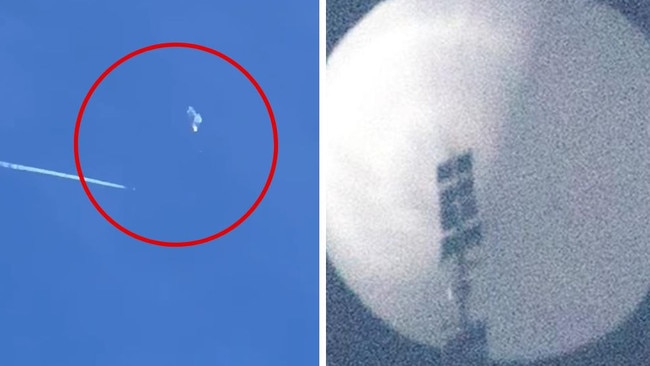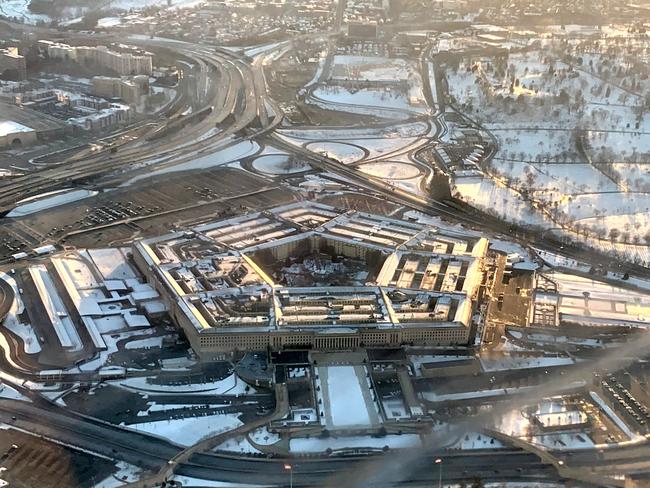Chinese ‘spy balloon’ shot down after flying over US missile sites
Incredible details are emerging about what happened in the skies over US territory today as China’s secret weapon was exposed.

World
Don't miss out on the headlines from World. Followed categories will be added to My News.
A video shows the chilling moment a suspected Chinese spy balloon was shot down after floating over sensitive US missile sites.
A US fighter jet shot down the balloon over the Atlantic Ocean, off the coast of South Carolina, on Saturday afternoon, local time.
The move comes days after the “spy balloon” controversy first erupted when it was spotted flying over the US last week.
It was part of a “fleet” of Chinese surveillance balloons that have previously been spotted over Latin America, Europe and Asia, the Pentagon said after it was shot down.
China had claimed it was a weather balloon that had blown off course but US officials said that explanation “lacked any credibility.”
BREAKING 🚨: The US has shot down the Chinese Spy Balloon over the Carolina coast pic.twitter.com/tHid39bUcY
— Latest in space 🪠(@latestinspace) February 4, 2023
Video shared on Saturday afternoon (Sunday morning AEDT) showed the balloon exploding.
Afterwards, US President Joe Biden said he had ordered the Pentagon on Wednesday to shoot down the balloon “as soon as possible” but the Pentagon decided to wait until it was over the Atlantic Ocean – still in US territorial waters.
Biden did not respond to a question about how the shootdown might affect the country’s already strained relations with China.
He did say he wanted to “compliment our aviators” who shot the balloon down “successfully”.
The balloon was hit with a missile shot from an Air Force F-22 Raptor jet fighter and the debris fell into relatively shallow water just 47 feet (14m) deep. It was spread out over at least 11km, according to officials.
The balloon had been flying as high as 65,000 feet (20km) when it was shot from below by the plane, flying at 58,000 feet (18km).
The Wall Street Journal reported US navy ships and Coast Guard vessels were in the water and were expected to lead efforts to recover any surveillance equipment from the balloon.

In a statement, Secretary of Defense Lloyd Austin said: “Today’s deliberate and lawful action demonstrates that President (Joe) Biden and his national security team will always put the safety and security of the American people first while responding effectively to the PRC’s unacceptable violation of our sovereignty.”
PRC refers to the People’s Republic of China.
The balloon first entered US airspace over Alaska on January 28, Pentagon officials told reporters Saturday, before drifting over Canada and then back into the United States days later.
“We are confident it was seeking to monitor sensitive military sites,” a senior defence official said.
It was not the first time in recent history such an aircraft had flown over US territory, the senior defence official said, though this was the longest time one had spent in the country – three balloons were spotted during Donald Trump’s presidency and another one earlier in the Biden administration.
Hours before the balloon was downed, Biden told reporters, “We’re gonna take care of it.” However, he did not elaborate.
US aviation authorities closed down three airports in the eastern part of the country due to a “national security effort” on Saturday.
Arrivals and departures were paused at three airports in the states of South and North Carolina “to support the Department of Defense in a national security effort,” the Federal Aviation Administration told AFP in a statement.

On Thursday, American officials said they were tracking a large Chinese “surveillance balloon” in US skies, but decided not to shoot it down over concerns of hurting people or property on the ground.
That led Secretary of State Antony Blinken on Friday to scrap a rare trip to Beijing.
After initial hesitation, Beijing admitted ownership of the “airship,” but said it was a weather balloon that had been blown off course, adding that it regretted the situation.
“The airship is from China. It is a civilian airship used for research, mainly meteorological, purposes,” China’s foreign ministry said in a statement Friday.
“The Chinese side regrets the unintended entry of the airship into US airspace due to force majeure,” it said, using the legal term for an act outside of human control.
The balloon had flown over parts of the northwestern United States that are home to sensitive air bases and strategic nuclear missiles in underground silos, adding to concerns.
Another suspected Chinese spy balloon was seen over Latin America, the Pentagon said Friday, without providing specifics as to its location.
Expert weighs in on seriousness of Chinese ‘spy balloon’
William Kim, a specialist in surveillance balloons at the Marathon Initiative think tank in Washington, told AFP the balloon over the US looked like a normal weather balloon but with distinct characteristics.
It has a quite large, visible “payload” — the electronics for guidance and collecting information, powered by large solar panels.
And it appears to have advanced steering technologies that the US military hasn’t yet put in the air.
Artificial intelligence has made it possible for a balloon, just by reading the changes in the air around it, to adjust its altitude to guide it where it wants to go, Mr Kim said.
“Before you either had to have a tether … or you just send it up and it just goes wherever the wind takes it,” he said.
“What’s happened very recently with advances in AI is that you can have a balloon that … doesn’t need its own motion system. Merely by adjusting the altitude it can control its direction.”
That could also involve radio communications from its home base, he said.
But “if the point of it is to monitor [intercontinental ballistic missile] silos, which is one of the theories … you wouldn’t necessarily need to tell it to adjust its location,” he added.

What advantages over satellites?
Mr Kim said that as satellites become more vulnerable to being attacked from the Earth and space, balloons have distinct advantages.
Firstly, they don’t easily show up on radars.
“These are materials that don’t reflect, they’re not metal. So even though these balloons expand to quite large, detecting … the balloon itself is going to be a problem,” he said.
And the payload, if small enough, can be overlooked.
Balloons also have the advantage of holding relatively stationary positions over a surveillance target, compared to constantly orbiting satellites used by spy agencies to take photographs.
“These things can stay overhead, they can stay over one spot months at a time, compared to the low-Earth-orbit satellites,” Mr Kim said.
Extremely close shot of the China balloon going over Washington, MO. #ChineseSpyBalloon#ChinaBalloon#missouri#washmopic.twitter.com/SyBU9F3QwC
— TSchlitt-Photography (@Stormchaser_TS) February 3, 2023
Could it have entered US airspace by accident?
Mr Kim called it a “real possibility” that a Chinese balloon may have been intended to collect data from outside US boundaries or much higher but malfunctioned.
“These balloons don’t always work perfectly,” he said.
The balloons usually operate at altitudes of 65,000-100,000 feet (20-30 kilometres), and this one is at around 46,000 feet, he said.
“That’s definitely a little low … If you wanted it to be harder to spot, if you want it to be harder to shoot down, then it would make sense to operate at higher altitudes.”
Originally published as Chinese ‘spy balloon’ shot down after flying over US missile sites




